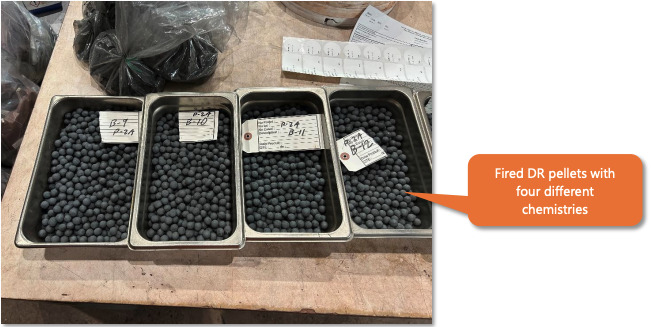Rumours of iron ore’s demise have been greatly exaggerated

Mourning the death of iron ore? Maybe you should hold that thought. Pic: Getty Images
- Ex-Rio and Arcelor Mittal executive Paul Berend says mainstream analysts have it wrong on iron ore’s future
- Now head of Canadian-focused junior Cyclone Metals, Berend says China’s need for the commodity remains strong
- At higher prices juniors working under the radar on iron ore projects could have their day in the sun
Iron ore’s future has been persistently painted as a fragile one by mainstream analysts, who view the plateau and probable decline in Chinese steel production as well as a dramatic slowdown in its property sector as a sign of price declines to come.
That is reflected in the understandably conservative forecasts of bodies like the Australian and West Australian Treasuries. Given how dependent their budgets are on iron ore, the US$71/t price they tip is important to avoid overspending and, more cynically, to ensure politically beneficial ‘surprise’ budget improvements in mid-year updates.
But do investors need to be so cynical about the sector?
While prices have briefly dropped below US$90/t on a number of occasions since falling from all time highs of US$237/t in May 2021, they’ve always rebounded back above US$100/t.
The latest recovery, which has seen Singapore 62% Fe futures lift to US$106/t from under US$90/t in mid-September, has come on the back of enthusiasm around Chinese stimulus measures. Since those were announced, with more expected to emerge from a parliament meeting this week, banks have turned more bullish with Deutsche Bank tipping US$130/t prices next year and Citi saying they could hit US$120.
BHP (ASX:BHP), the world’s third largest exporter of seaborne iron ore, has regularly explained this phenomenon as a function of steepening cost curves. After the Brumadinho disaster curbed Vale’s supply out of Brazil in January 2019, marginal supply increases have come not from high margin majors like BHP and Rio Tinto (ASX:RIO), but from small producers operating at a higher breakeven.
As prices drop below US$100/t they become lossmaking and drop out of the supply chain, forcing steel mills to find other suppliers.
At the same time, its chair Ken MacKenzie and Rio CEO Jakob Stausholm have both commented that green technology is picking up the slack from the property sector, with China’s leading position in solar, wind and EVs ramping industrial demand for steel.
Brighter future
Among the miners sharing their optimism is Paul Berend, once high up at both Rio and European steel and iron ore producer ArcelorMittal.
Now the CEO of Canadian high-grade iron ore developer Cyclone Metals (ASX:CLE), the steel supply chain veteran says a number of big banks have the market worked out all wrong.
“I’m a bit contrarian to most analysts,” he told Stockhead.
According to Berend, even with the volume of iron ore China imports (~1.1Btpa) at a 5% GDP growth rate it could need as much as 50Mt of additional material a year to maintain that sort of economic activity. While official figures are yet to drop, ship tracking data showed China was on track to import a record 120Mt in October.
“(High grade new African mine) Simandou is 70Mtpa,” he said.
“So when people say ‘oh, Simandou is going to disrupt the market’, the snowball effect is such that you’ve still got shortages of raw materials.
“That’s the reason why you see iron ore swerving around US$100-120/t for the last four or five years in spite of analysts constantly predicting the prices are going to drop down to US$60, $70, $80/t.
“That never happens and it can’t happen”.
At the same time as countries like China and emerging economies in India and Southeast Asia look to grow, Berend says the quality of resources mined by the majors is decreasing.
Rio Tinto, notably, has been forced to review its sales strategy with its low grade SP10 blend becoming a significant part of its sales mix, something that will continue until the end of the decade when the 40Mtpa Rhodes Ridge JV near Newman is delivered and the flagship Pilbara Blend returns to 85% of exports. An environmental scoping document on Monday suggested it would take until mid-2028 for the project to be approved.
“I used to work at Rio back in 2006-7 and we had eight mines operating to get to the Pilbara Blend. It’s now 15,” Berend said.
While enthusiasm has waned since the heady days of 2021, Berend believes it will make resources developed by iron ore juniors like Cyclone stand out as established producers look elsewhere for growth and quality.
“There is a depletion of resources, the majors know it and that makes assets like our even more attractive,” he said.
Labrador, not just a cute dog
Cyclone’s attention is focused on the large Iron Bear magnetite resource in Labrador, down the road from the Bloom Lake complex mined by $3 billion capped ASX-TSX mid-cap Champion Iron (ASX:CIA).
Having bought Bloom Lake for a pittance from steel producer Cleveland Cliffs during the 2015-16 downturn, Michael O’Keeffe’s iron ore producer now sends 15Mtpa of premium high grade concentrate overseas annually and could lift output eventually into the 20Mtpa+ range if it decides to develop the satellite Kami mine.
Cyclone’s Iron Bear contains a resource of 16.6Bt at 29.2% iron, but that grade is misleading since magnetites like Iron Bear, unlike WA hematites that are higher grade in situ, can be processed into a premium product.
So far Cyclone’s test work has established it can produce a direct reduction grade concentrate grading 71.3% iron and 1.1% silica and DR-grade pellets containing 67.5% Fe, 1.6% SiO2, 0.12% MgO, and 0.65% CaO, delivered at a pilot plant in Quebec last quarter.

DR pellets carry a premium of around US$30/t over blast furnace grade pellets and, unlike blast furnace pellets, do not have a ready replacement like BF pellets do in the form of iron ore lump.
Direct reduced iron isn’t a new technology, but the factories, which use gas or in the future hydrogen as their reducing agent rather than coal, are becoming more popular especially in Europe because they generate a fraction of the CO2 emissions as blast furnaces.
At the same time, supply of DR grade material is only in the order of 125Mtpa currently from a handful of significant suppliers.
“The direct reduction market is quite small, about 10% of the overall market, people talk a lot about it,” Berend said.
“The only reason it’s of interest to Iron Bear is the fact that there’s only three producers in the world who can produce large volumes of direct reduction grade pellets on the seaborne market – Vale, Samarco, LKAB and LKAB have recently said they don’t want to export it they want to make steel.
“There’s (Rio’s) IOC, but they switch stuff on and off. It’s really hard to make DR material, Champion Iron hasn’t been able to produce DR grade material.
“DR is typically below 2% silica and it has to have a whole bunch of other qualities which are really complicated.
“You can only demonstrate that you’ve got a DR grade pellet when you’ve tested it in a direct reduction unit, which we are right now.”
Cyclone has a small market cap, often a barrier to developing large resources like Iron Bear. But Berend says by taking on the technical risk majors normally struggle to, he is confident the company – which is currently going through a share consolidation – can bring a deep pocketed partner on board.
In the Pilbara
While Cyclone has set its sights on the Canadian magnetite market, there are plenty of explorers still finding new hints of iron ore in the well-established Pilbara region, which if proven up could have a ready path to market.
They include Tolga Kumova backed Macro Metals (ASX:M4M), which is currently undertaking a 6000m drill programme at its Goldsworthy East project in WA.
M4M turned heads when it disclosed the discovery of high grade iron ore outcrops of up to +64% Fe at Goldsworthy East, which sits adjacent to the historic Mt Goldsworthy mine where BHP produced 55Mt at 63.5% Fe between 1965 and 1982.
Its location is extremely advantageous should Macro find a deposit of even modest scale. The Utah Point bulk handling facility, designed for junior exporters but largely used now by MinRes and Gina Rinehart’s Atlas Iron, is under 100km away. That’s a boon given it’s the remoteness of many small iron ore deposits that hits their bottom line.
QX Resources (ASX:QXR) is planning a rock chip sampling project over a 4km long enriched banded iron formation at Western Shaw, just 15km from the Roy Hill and Fortescue (ASX:FMG) rail lines.
It found rock chip samples earlier this year going at 58.5% Fe, a standard low grade iron ore product if found in greater abundance. The ground wasn’t subject to broader exploration despite the discovery by Atlas Iron over 15 years ago of rock chips running in excess of 62% Fe.
“Previously, enriched surface iron ore over BIF sequences with chert horizons was sampled over 4.4km but extends over 8km within the Western Shaw leases,” QXR said in its latest quarterly report. “A new sampling program of 250m spaced rockchip traverses has been planned over the full 8km outcrops but was delayed due to appropriately skilled personnel availability.”
The explorer, which also has lithium assets in the US and copper/gold prospects in Queensland, says discussions are underway on the expanded rock chip program.
Also in the Pilbara Equinox Resources (ASX:EQN) holds an inferred mineral resource of 108.5 million tonnes at 58% Fe over its Hamersley project, but was prevented from conducting additional infill drilling after the registration of a new Aboriginal heritage site on its ground.
The explorer has applied for judicial review of a Ministerial decision not to grant consent to drill in the previously explored area, but has also designed a revised infill drill program to “avoid any risk to the newly identified ethnographic sites outlined by the WGAC (Wintawari Guruma Aboriginal Corporation).”
A native title agreement with the WGAC is in place at the project, where 168 holes for ~22,700m have been drilled to date.
There have been a couple iron ore success stories in the past year. Mark Creasy backed CZR Resources (ASX:CZR) will bank $102 million for shareholders for its Robe Mesa project near Ashburton if the Foreign Investment Review Board approves its sale to Chinese-linked Miracle Iron after a lengthy review process, while Red Hawk Mining (ASX:RHK), the former Flinders Mines, has emerged as one of the better junior resources performers on the ASX outside precious metals in 2024 after revising its bulky, low grade Pilbara Iron Ore Project into the smaller Blacksmith.
Elsewhere, Fenix Resources (ASX:FEX) has set the template for growth as a junior iron ore producer, progressively taking control of its transport and port infrastructure to expand beyond its small but high grade Iron Ridge mine near Geraldton.
At Stockhead, we tell it like it is. While Cyclone Metals, QX Resources and Equinox Resources are Stockhead advertisers they did not sponsor this article.
Related Topics
UNLOCK INSIGHTS
Discover the untold stories of emerging ASX stocks.
Daily news and expert analysis, it's free to subscribe.
By proceeding, you confirm you understand that we handle personal information in accordance with our Privacy Policy.








